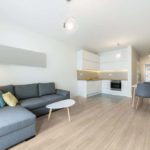The potential for nuisance noise within multi-occupancy buildings, where residents live above, below and adjacent to one another, is understandably high, as sound can easily travel from floor to floor and room to room. Here, Karen Wilding, Segment Marketing Manager for Housing at Forbo Flooring Systems, explains the importance of minimising noise within these settings and how this can be achieved with acoustic floor coverings.
The UK’s population continues to rise, which is putting greater demand on the housing market than ever before. With the nation still struggling to build the requisite number of new homes, there is now an increased demand on local authorities to provide multi-occupancy buildings, such as flats and house-shares to local people [1]. In the modern era, such properties represent a more affordable option for those looking to buy, or rent, particularly in areas like London, where property prices continue to boom. Despite their advantages, multi-occupancy buildings do have their design challenges. Most notably, such buildings can fall victim to excess noise problems, which transfer easily from room to room and from floor to floor. Fortunately, developments in the acoustic floor covering market now offer an effective way to help handle the issue.
The primary concern when looking to ensure effective acoustic performance in multi-occupancy housing relates to the spread of noise between floors and rooms. Without the proper precautions, residents in multi-occupancy properties can be affected by unwanted noise from their neighbours. In turn, this can become a particularly problematic issue when it starts to affect individual’s ability to sleep, and often ends up manifesting in physical and mental health ailments. Similarly, exposure to excess noise levels has been linked to increases in the risk of developing serious cardiovascular diseases, as well as contributing to a greater likelihood of hearing loss [2] [3]. As such, there’s a strong onus for local authorities to design multi-occupancy buildings in ways that limit the amount of noise transfer between rooms.

Impact noise
In this endeavour, it is often best to look towards acoustic flooring solutions, which help to limit excess noise levels, particularly between floors. Across the market, there are now a number of high-performing acoustic flooring solutions capable of the task. In general, these solutions are used primarily to help local authorities to tackle impact noise. Managing impact sound is underpinned by standard EN ISO 717-2, which relates to impact sound reduction. When evaluating potential floor coverings, local authorities can compare acoustic performance against this standard to find the most effective solutions.
Indeed, there are a great variety of solutions to choose from, which range in their ability to reduce impact sound within multi-occupancy properties. Historically, acoustic vinyl solutions have tended to offer one of the highest levels of noise-reduction performance. As well as contributing to sound-controlled environments, acoustic vinyl solutions are also heralded for their exceptional durability, providing an ideal solution in areas of heavy foot traffic.
There are also solutions available which have been designed to offer best in class indentation resistance, making them ideal for rooms where heavy furniture may be placed, or moved around frequently. More recently, a number of acoustic textile floor coverings have been developed that deliver even greater acoustic performance, some of which are able to reduce sound by up-to 30 dB. Additionally, textile floor coverings are also able to deliver a softer look and feel in corridors or communal areas.

Adhesive free solutions
For local authorities, it is also important to find acoustic floor covering solutions that are cost-effective, easy-to fit and simple to clean. With regards to installation, local authorities can now look towards adhesive free vinyl solutions, which can be installed quickly and walked on immediately after installation. As the name suggests, adhesive free vinyl requires no adhesive, tackifier or double-sided tape to fit, helping local authorities to reduce downtime and minimise impact on day-to-day operations. For those looking for an environmentally conscious solution, acoustic linoleum options offer those managing multi-occupancy properties, as well as tenants, a low maintenance solution, which can be cleaned easily, without the need for specialist tools or chemicals.
Forbo Flooring Systems is proud to offer a portfolio of effective acoustic floor covering solutions across all of the aforementioned categories, which have been specially engineered to help property owners and local authorities create more harmonious and sound-controlled environments that limit the risks to mental and physical health in occupants.
The collection includes its industry-leading Sarlon collection, which has been developed and tested to maximise impact sound reduction, whilst also meeting the needs of heavy traffic environments, and Modul’up Decibel, an acoustic vinyl flooring that is part of its Fast Fit range. Also included is Allura Decibel luxury vinyl tiles and Surestep Decibel, which offers sustainable, HSE compliant enhanced slip resistance, as well as an acoustically enhanced version of its popular flocked flooring option, Flotex, called Flotex Acoustic Plus, which offers acoustic protection of up-to 22 dB. Therefore, for local authorities looking to tackle this pressing issue, this range of products offers a reliable and effective solution.
[1] Timan, J., 2020. Rise In Homelessness Drives Social Housing Demand As Over 200 Apply For Each One. [online] Manchester Evening News. Available at: <https://www.manchestereveningnews.co.uk/news/greater-manchester-news/homelessness-social-housing-demand-200-19178062>
[2] Dtsch Arztebl Int. 2019 Apr; 116(14): 245–250. Published online 2019 Apr 5. doi: 10.3238/arztebl.2019.0245
[3] HSE.Gov. 2020. Noise Induced Hearing Loss. [online] Available at: <https://www.hse.gov.uk/food/noise.htm>









